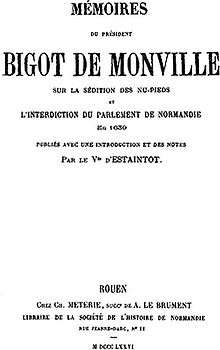Revolt of the va-nu-pieds

The Revolt of the va-nu-pieds (French pronunciation: [vanypje], barefooted ones) was a popular uprising in Normandy in 1639 following Louis XIII of France's decision to set up the gabelle in Cotentin in place of the privilege of the quart-bouillon.
Context
The Nu-Pieds revolt was the culmination of a series of troubles or “agitations” that shook Normandy for more than a decade. For some time, the royal budget had been in deficit (58 million livres in 1639 at a total expenditure of 172 million). To finance itself, the kingdom issued fical expedients. Normandy, one of the richest provinces of the kingdom, was obliged to make strong contributions. Each time, the fiscal pressure provoked problems, like in Rouen in 1623, when people protested against the obligation to pay charges for brouettiers, for chiffonniers etc. to the tax office; or in 1628 and 1634 in protest against a tax on leather markings.
Etymology
The term “va-nu-pied” appeared in 1639 in the work Histoire des Secretaires d’État (History of State Secretaries) by Antoine Fauvelet du Toc under the spelling “Va nuds pieds” and, from 1646, in the columns of the journal Mecure François under the name “Jean va Nuds-pieds” (“John walks Barefooted”). The expression is the origin of the noun “va-nu-pieds” which has an invariable form.
Notes
Bibliography
- Pierre Carel, Une émeute à Caen sous Louis XIII et Richelieu (1639) : la révolte des Nu-Pieds en Basse-Normandie, Caen, E. Valin, 1886 ;
- Madeleine Foisil, La Révolte des nu-pieds et les révoltes normandes de 1639, Paris, PUF, 1970 ;
- Jean-Louis Ménard, La Révolte des nu-pieds en Normandie au XVIIe siècle, Paris, Dittmar, 2005 ;
- Boris Porchnev, Les Soulèvements populaires en France de 1623 à 1648, S.E.V.P.E.N., Paris, 1963 ; reprinted as Les soulèvements populaires en France au XVIIe siècle, Flammarion, Paris, 1972.
- (French) Mémoires du président Bigot de Monville sur la sédition des nu-pieds et l’interdiction du parlement de Normandie en 1639, Rouen, Métérie, 1876